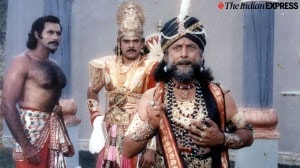Derailway Minister Nitish
With no signs of an end to the nightmare on tracks, the Railways this morning stared at Accident No. 3 in barely two months when a speeding ...

With no signs of an end to the nightmare on tracks, the Railways this morning stared at Accident No. 3 in barely two months when a speeding Golconda Express plunged from a Warangal bridge onto a busy road below, killing 18 and causing serious injuries to 32.
In Patna, Union Railway Minister Nitish Kumar shrugged off the incident while rescue work was still on. He ordered the customary probe by the rail safety commissioner and at the same time heaped blame on the engine driver, claiming he had overshot a signal.
|
10 months, over 280 dead, only 12 (Minister not included) held ‘accountable’ |
|
|
• September 10, 2002: 130 killed as Howrah-New Delhi Rajdhani derails near Rafiganj in Bihar. Railway Minister Nitish Kumar and then Chairman Railway Board blame it on sabotage. Commissioner Railway Safety (CRS) enquiry calls it ‘‘engineering failure.’’ No action against any railway personnel so far. • December 21, 2002: 20 killed as Kachiguda-Bangalore Express derails near Ramliangayapalli in Andhra Pradesh. Nitish uses the ‘S’ word – Sabotage. CRS report awaited. No action against any one. • January 3, 2003: 20 killed as Kachiguda-Manmad Express rams into stationary goods train near Ghatnandur, Maharashtra. Six personnel were suspended. These included driver of goods train who abandoned the train on the main line demanding a replacement driver, and also Divisional Safety Officer, Assistant Station Master, two pointsmen and a traffic inspector of Ghatnandur. Ghatnandur staff had absconded after the accident. • May 15, 2003: 38 killed as three coaches of Frontier (Golden Temple) Mail catch fire near Ludhiana. Once again, Nitish calls it sabotage but CRS report inconclusive. No action against anybody. • June 23, 2003: 53 dead as Karwar-Ahmedabad holiday special derails on Konkan Railways. Nitish calls it ‘‘nature’s fury.’’ Sources claimed it was negligence, lack of maintenance and absence of monsoon patrolling. No action. Story continues below this ad • Yesterday: 18 killed as Golconda Express derails and falls off near Warangal. Nitish blames the train driver. CRS enquiry ordered. Six officials suspended for dereliction of duty, pending enquiry. |
But Railway officials on the ground didn’t seem so sure: some said the driver was at fault, others pointed to a possible failure of the brake system.
The dead included six on the road below, crushed beneath the engine and the coaches.
The casualty numbers could rise because some passengers were believed to be still trapped inside the mangled coaches. Rescue workers, battling heavy rains, were using gas-cutters to find their way in.
The incident occurred around 10.30 am, four hours after the Secunderabad-bound train left Guntur. People waiting at the Warangal railway station watched as the train, instead of halting, hurtled past them and jumped onto a loopline. It then derailed and plunged from the bridge, crushing an auto-rickshaw and a motorcycle on the road below.
Engine driver Mohammed Rashid and assistant driver Sammaiah, though injured, fled the spot. Four hours later, their relatives admitted them to the Mahatma Gandhi Memorial Hospital. Officials said both were unable to recall what exactly happened.
Chief Minister Chandrababu Naidu, who rushed to the accident site, said there was need for an impartial probe. South Central Railway general manager T Stanley Babu said the train entered the station at high speed. ‘‘This possibly suggested failure of the brake system or a lapse on the part of the driver. It will be known only after the engine is pulled out and examined by the probe officials,’’ he said.
Other officials blamed the driver: ‘‘It appears the driver oversped on a yellow signal where the speed limit is 30 kmph. But the train was running close to 45 kmph. The driver entered the loop line at a much higher speed and lost control. The engine hit a sand hump which was the dead-end and went off the bridge.’’
Sources conceded the accident only highlighted the ills plaguing the railways. ‘‘It’s a must for the authorities to ensure that the dead-end of a loop line is properly strengthened and does not give away easily on high impact. It’s gross negligence that the dead-end at such an important station (Warangal) on the high density Route A was so weak, made of mere sand. What’s more, the driver over-sped and lost control of the train. This is criminal,’’ sources said.
The series of accidents—six major ones in just nine months—point to a railway management gone offtrack. These include the derailment of Howrah-New Delhi Rajdhani in September last, destroying the myth of the train which could never fail. And the derailment of the Karwar-Ahemdabad holiday special on Konkan Railway late last month proved that the stretch was not the accident-proof wonder made out initially.
But the accident-rate of South Central Railway has emerged as a disturbing trend. Apart from today’s derailment, there have been two major accidents in recent past on the SCR — both reflecting lack of disclipline and maintenance.
The collision of Kachiguda-Manmad Express with a stationary goods train near Ghatnandur railway station in January killed 20 people. The inquiry shockingly revealed that the driver of the goods train had left the train standing on the main line for three hours, asking for a replacement driver. He claimed that he had been on duty for 12 hours at a stretch. The Ghatnandur station staff failed to provide proper directions to the passenger train and this resulted in the collision.
A fortnight before that, 20 passengers were killed when Bangalore Express derailed near Ramliangayapalli in Andhra Pradesh. The accident was blamed on sabotage by the Railway ministry though the report of Commissioner Railway Safety (CRS) was still awaited.
The other accident, which Nitish Kumar initially said was sabotage, turned out to be an ‘‘engineering failure.’’
The minister and senior officials, including then CRB I I M S Rana, had blamed the derailment of Howrah Rajdhani near Rafiganj in Bihar on sabotage and even mentioned the possibility of ISI involvement. CRS Mahesh Chand had then said it was an engineering failure.
Despite all this, Nitish seems to be preoccupied with his constituency Barh and Samata party politics. For example, his decision to construct a 123-km Fatuah-Islampur line at a cost of Rs 225 crore without the requisite clearances from the Planning Commission—first reported by The Indian Express—under the garb of ‘‘material modification.’’ The same project had erlier been panned by Comptroller and Auditor General (CAG) since surveys had found that it was not going to be economically viable.
Recently, he got President A P J Abdul Kalam to inaugurate a loco workshop at Harnaut, his birthplace in Bihar. A former Chairman Railway Board (CRB) Ashok Kumar had earlier refused to clear the project, going on record to say that it was not required. Finally, he had his way and got the foundation stone laid for Rs 80-crore workshop.
Nitish has also had to withdraw some of his Jan Shatabdi trains — announced with much fanfare for populist reasons — for low occupancy.





- 01
- 02
- 03
- 04
- 05


























